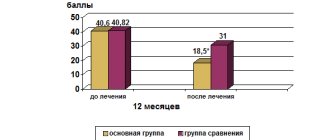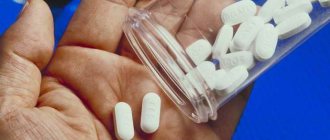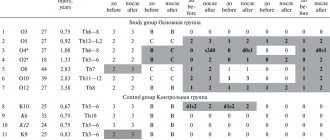Indications
Non-invasive transcranial (translated from Latin as “through the skull”) electrical stimulation is one of the few methods of physical therapy with scientifically proven effectiveness. The impact of pulsed current has analgesic, immunostimulating effects, activates regeneration processes, and regulates vascular tone. Indications for sessions are:
- pain syndrome due to neurological pathologies, cancer, extensive burn lesions, as well as phantom pain;
- depression, neurosis, anxiety;
- trophic ulcers, deep burns;
- arterial hypertension;
- chronic infectious diseases;
- low immune status;
- toxicosis during pregnancy;
- dermatological pathologies (neurodermatitis, atopic dermatitis, eczema);
- neurotic conditions against the background of menopause;
- sensorineural hearing loss;
- pathologies of the endocrine system;
- allergy;
- inflammatory diseases of autoimmune etiology (rheumatoid arthritis, psoriatic arthritis);
- alcohol or drug addiction;
- Parkinson's disease;
- insomnia.
Stimulation of the production of one's own endorphins helps relieve even severe pain; their effect is approximately 20 times stronger than the effect of morphine. For deep skin lesions, electrical stimulation activates reparative regeneration and helps slow tumor growth.
Carrying out the procedure
A transcranial electrical stimulation session lasts about 30 minutes. The patient is placed in a sitting or lying position. Electrodes are attached to the scalp, to which a low-power pulsed current is supplied from the device. A specific arrangement of electrodes is used, taking into account the direction of current application (from the forehead to the mastoid processes) and the resonant parameters of the current. The procedure is completely painless; the patient may feel slight vibration, warmth, and tingling in the area of treatment.
During the session, the doctor controls the person’s sensations in order to regulate the strength of the current supplied. As a rule, during the first procedure the current strength is not changed. In subsequent sessions, the specialist may slightly increase the impact to achieve a more pronounced effect. The required number of procedures is about 10, determined individually for each patient.
The skin under the electrodes does not suffer and looks exactly the same as before the session. No complications or negative consequences of the procedure were identified.
Indications for interstitial electrical stimulation using the Gerasimov method
Interstitial electrical stimulation using the Gerasimov method is used for the following diseases:
- osteochondrosis;
- intervertebral hernia;
- arthrosis and arthritis;
- migraine;
- osteoarthritis;
- periarthritis of the shoulder joint;
- vegetative-vascular dystonia.
The procedure has the following advantages:
- painless;
- has no side effects, does not cause complications;
- allows you to refuse drug therapy;
- in 90-95% of cases it leads to the disappearance of pain due to osteochondrosis;
- increases the remission period by 3 times compared to traditional medicine methods.
Electrical stimulation according to Gerasimov is an alternative to surgical treatment; it allows you to cure the disease 3-4 times faster compared to other methods, including laser technologies. Under the influence of therapeutic current, not only the symptoms of the disease are eliminated, but also the cause, and the structure of the tissues of the peripheral nervous system is restored. The effect is noticeable after 1-2 sessions, and the stability of the treatment is visible after 1-2 weeks. A full cycle of electrical stimulation consists of several individually prescribed sessions of 30 minutes each, which are carried out with a break of 1-2 days and do not require bed rest.
Equipment used
To conduct sessions, special equipment is used that generates pulsed currents. The devices are designed taking into account safety and ergonomic standards.
Currently, the most widely used devices for transcranial electrical stimulation are:
- Etrans-1, Etrans-2, Etrans-3;
- Transair (modifications 02, 01В, 01С, 01П);
- MDM-1, MDM-101.
Various devices have been developed, both stationary and portable. Some models are intended for professional use in medical institutions. There are also devices for carrying out procedures at home.
Effect of transcranial electrical stimulation
During clinical studies, the following effects of this method of physical influence were confirmed:
- pronounced analgesic effect even in those patients whose pain syndrome is not relieved by medication;
- antidepressant effect, normalization of psychophysiological processes, improvement of performance, elimination of chronic fatigue syndrome;
- improved sleep;
- activation of regeneration of all types of tissues;
- stimulation of the immune system, increasing the body's resistance;
- normalization of vascular tone and, as a result, blood pressure;
- improvement of well-being, reduction of pain intensity and inhibition of the development of tumor processes in cancer;
- relieving symptoms of acute withdrawal in patients with alcohol and drug addiction, reducing cravings for alcohol and drugs, eliminating disorders that arise during the period after abstinence;
- reduction in the intensity and frequency of allergic reactions; after sessions, you can reduce the dosage of antiallergic drugs;
- relief of inflammation in infectious and autoimmune diseases.
Transcranial electrical stimulation can effectively treat many pathologies and improve results from the use of medications while reducing the dosage.
You can undergo treatment with transcranial electrical stimulation in Moscow in most clinics. You can sign up for the procedure at the selected institution by phone. The price of one session ranges from 500 to 2500 rubles, depending on the level of the institution and the type of equipment used.
TES therapy
The analgesic effect of TES therapy is comparable to or exceeds the effect of analgesics, but does not cause adverse reactions. TES therapy is one of the first methods in which its ability to non-invasively, selectively and in a strictly dosed manner activate the structures that produce endogenous opioid peptides (EOPs) has been proven, which opens up broad prospects for its further use. The image intensifier is the most important system of the body, regulating the activity of the neuro-immuno-endocrine system of the body. TES selectively (selectively) activates the brain image intensifier structures that produce β-endorphin using pulsed electrical action supplied through the head cutaneous electrodes. To achieve the specified selectivity in TES therapy, it is necessary to adhere to two basic principles:
- direction of current application (forehead - mastoid processes)
- resonant characteristics of the current in relation to the image intensifier tube.
Transcranial electrical stimulation can be prescribed not only to children, but also to children from 7 years old!
Indications for TES therapy
Relief of pain syndromes in neurology and other areas of medicine (according to St. Petersburg State Medical University named after academician I.P. Pavlov, Military Medical Academy, NIIEM, MAPO, N.V. Sklifosovsky Research Institute of Emergency Medicine and more than 300 medical institutions in Russia, CIS countries, Israel , Bulgaria).
- Spondylogenic pain, radiculitis, osteochondrosis.
- Headaches of various origins.
- Postoperative pain.
- Neuritis, neuralgia, sciatica.
- Orofacial pain (trigeminitis, glossalgia).
- Fibromyalgia.
- Pain due to deforming arthrosis.
- Domestic trauma.
- Pain syndromes in diseases of internal organs.
| Cost of TES therapy | Price |
| Transcranial electrical stimulation (device "Transair") | 500₽ |
The duration of the procedure is from 10 to 40 minutes.
Description of the TES therapy method
Pulse therapy of the central nervous system is usually carried out in courses. The physiotherapist prescribes their number individually, depending on the task and the patient’s health condition.
The session takes place in a lying or sitting position. Electrodes connected to a machine that produces weak electrical impulses are applied to certain points on the head (in the area of the forehead and temporal bones, called the mastoid processes). The patient may only feel a slight tingling sensation at the site of contact of the electrode with the skin.
At the end of the session, the electrodes are removed, and since the technique is non-invasive, there is no damage to the skin.
TES therapy in Cardiology
- Normalization of blood pressure: for hypertension; for hypotension; with neuro-circulatory (vegetative-vascular) dystonia;
- Treatment of acute uncomplicated myocardial infarction:
- Effective pain relief;
- Improvement of systemic and regional hemodynamics;
- Acceleration of healing of damaged myocardium.
TES therapy in Gastroenterology
- For gastric and duodenal ulcers, gastritis, duodenitis:
a) elimination of pain syndrome; b) 2-2.5 times acceleration of the healing of ulcerative defect against the background of normalization of the secretion of hydrochloric acid and gastrin; c) potentiation of anti-Helicobacter eradication therapy; d) normalization of appetite and intestinal motility; e) normalization of vegetative status; f) prevention of exacerbations of peptic ulcer disease.
- For toxic hepatosis, hepatitis and alcoholic cirrhosis:
a) reduction of cytolysis and degenerative changes in hepatocytes; b) normalization of the antitoxic and synthetic function of the liver.
- Normalization of the gastrointestinal tract in various forms of “irritable bowel syndrome”.
- Relief of esophageal and extraesophageal (ENT) manifestations of gastroesophageal reflux disease.
TES therapy for ENT pathologies
- For sensorineural hearing loss:
a) improvement or restoration of hearing; b) reduction of subjective tinnitus; c) facilitating hearing aid.
- Elimination of allergic and vasomotor rhinitis and their prevention.
- Prevention of recurrent nosebleeds.
- Stimulation of postoperative healing.
- Facilitation of the course of acute respiratory infections when used in the prodromal period.
- Effective treatment of ENT complications of gastroesophageal reflux disease.
TES therapy in Ophthalmology
- Relief of acute and chronic eye pain.
- Treatment of spasm of accommodation and weak myopia.
- Significant increase in distance visual acuity.
- Treatment of vascular and dystrophic eye diseases.
TES therapy in Obstetrics and Gynecology
- Treatment of premenstrual syndrome with normalization of hormonal status.
- Stimulation of ovulation in endocrine infertility.
- Relief of toxicosis in the first half of pregnancy.
- Pain relief for childbirth.
- Treatment of endometriosis.
- Relief of disorders during menopause.
- Treatment of dysfunctional uterine bleeding.
TES therapy in Pediatrics
- Possibility of using electrical stimulation starting from 5 years of age for all indications listed in other sections.
- Treatment of attention deficit hyperactivity disorder.
- Adaptation to school and preschool institutions.
- Increasing the resistance of frequently ill children during seasonal outbreaks of ARVI.
TES therapy in Dermatology and cosmetology
- Treatment of dermatoses of various localizations.
- Effective relief of itching.
- Treatment of superficial seborrhea.
- Treatment of psoriasis.
- Treatment of trophic ulcers.
- Treatment of pustular skin lesions.
- Reducing fragility and preventing hair loss.
- General improvement of the skin: improvement of microcirculation and trophism of the skin, normalization of elasticity and skin color.
TES therapy in the treatment of burns
- Relief of pain syndrome.
- Anti-stress effect, expressed in reducing the level of catecholamines, reducing anxiety, improving sleep, normalizing the gastrointestinal tract.
- Normalization of metabolism and increasing the effectiveness of parenteral and enteral nutrition.
- Acceleration of healing processes under the influence of beta-endorphin and growth hormone.
- Normalization of immunity due to activation of T helper cells and NK cells.
TES therapy in Oncology
- Relief of acute and chronic cancer pain.
- Inhibition of the growth of tumors of various localizations in the experiment.
- Increasing the effectiveness of antitumor chemotherapy.
- Subjective improvement of well-being and mood, improvement of the quality of life of cancer patients.
TES therapy in Urology
- Treatment of urinary incontinence due to overactive bladder.
- Use in complex treatment of pelvic pain.
TES therapy in Endocrinology
- Comprehensive treatment of type II diabetes mellitus.
- Treatment of manifestations of metabolic syndrome.
- Anti-stress protection of the macular retina during cataract surgery in patients with diabetes mellitus.
TES therapy in Sports Medicine
TES therapy provides:
- Increasing the effectiveness of the training process due to:
a) improving tolerance to peak loads; b) increasing performance during training; c) accelerating recovery after extreme stress.
- Possibility of improving sports performance.
- Relieving stress and eliminating depression caused by sports situations.
- Improving and accelerating adaptation to time zones and acclimatization.
- Accelerating recovery from sports injuries.
TES therapy in the treatment of Narcology
TES therapy in the treatment of alcoholism, opium addiction and substance abuse provides:
- Relieving withdrawal symptoms.
- Elimination of post-withdrawal affective disorders.
- Elimination of pathological attraction to alcohol and drugs.
- Improving the detoxification function of the liver.
TES therapy for Normalization of psychophysiological status
- Treatment of neurological, mental disorders with depression and neuroses.
- Treatment of reactive anxiety, chronic fatigue syndrome, restless legs syndrome.
- Elimination of stress phenomena of varying degrees of intensity in different conditions:
a) military-professional adaptation; b) victims of mass disasters, their relatives and rescuers, “loss syndrome”; c) post-traumatic stress.
- Improving the performance of healthy people.
Contraindications to the TES method are:
1. Presence of an electrical pacemaker;
2. Epilepsy or a history of seizures; 3. Thyrotoxicosis; 4. Presence of lesions on the skin at the intended locations of electrode application; 5. Decompensated stages of cardiovascular diseases (hypertensive crisis, heart attack, stroke); 6. Hydrocephalus; 7. Presence of brain tumors; 8. Acute period of traumatic brain injury; 9. Schizophrenia, acute psychosis (including alcoholic); 10. Infectious lesions of the central nervous system 11. Age up to 5 years. TES therapy is based on many years of research conducted at the Institute of Physiology named after. I. P. Pavlova RAS, St. Petersburg, under the guidance of Doctor of Medical Sciences, Professor V. P. Lebedev. Scientists were able to identify the dependence of the degree of activation of the image intensifier system on the main characteristics of the applied pulse current (pulse shape, repetition rate and duration) used in TES. It has been established that only in a very narrow range of pulse current characteristics is selective and reproducible activation of the image intensifier system achieved.










